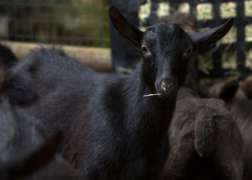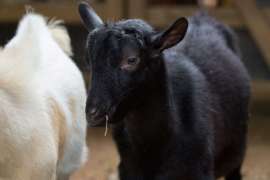Oberhasli Goat
Oberhasli Goat
The breed was originally developed in Switzerland and, though relatively rare in the U.S., remains highly sought after for its abundant production of milk. Goats were among one of the very first domesticated animals, and they have been part of human life as companions and a source of hides and foods for millennia. Many thousands of years of selective breeding have produced a large of number of breeds specialized for different purposes and climates.
Capra aegagrus hircus
Herbivore
Europe [VIEW MAP]
Urban Areas
Contact yard animals always have access to a quiet time area when they need a break from human affection. Guests may enjoy time with the animals anytime except during the coldest or rainiest conditions, but it will always be a surprise to find which specific breeds and individual animals are there to greet them.
Photos and Videos
The Oberhasli goat originated in the Canton of Berne in Switzerland. They were first imported to the U.S. in the early 1900s, but these original goats were crossed with other breeds and the pure line was lost in this country. It wasn’t until 1936 that purebreds were established and maintained. The breed was known as Swiss Alpine until 1977, when its name was changed to Oberhasli. The breed was not recognized by the American Dairy Goat Association until the 1960s, and there are relatively few Oberhasli goats registered in the U.S. Oberhasli goats can produce on average 1,600 pounds of milk per year with 3.6 percent butterfat content. Many goat packers prefer Oberhasli because of their sturdy conformation and fearless manner.
The Oberhasli coat color is generally light tan to deep reddish brown with black points. Oberhasli goats can also be black in color as a result of recessive genes. These goats have erect ears and straight faces.
A mature female stands at least 28 inches at the withers (top of the shoulder blades) and weighs 120 pounds or more. Males stand approximately 30 inches tall and weigh 150 pounds or more.
These goats live about 10 years, with sexual maturity reached at 3 to 12 months of age. Breeding season is in the fall, and the cycle of a doe lasts 17 to 23 days. Estrus lasts 12 to 48 hours. Gestation lasts 148 to 156 days and results in twins or even triplets.
Bucks smell to tell if a doe is in estrus by the behavior known as “flehmen.” In this behavior, they extend their necks and heads into the air and curl up their upper lips.
Contact yard animals always have access to a quiet time area when they need a break from human affection. Guests may enjoy time with the animals anytime except during the coldest or rainiest conditions, but it will always be a surprise to find which specific breeds and individual animals are there to greet them.
This breed was developed in Switzerland. They are now maintained as domestic animals worldwide, but purebred lines are not very common.
At the Zoo, we offer the goats a varied diet of Bermuda hay, browse (clippings from non-toxic plants across the Zoo), some grain and produce.


